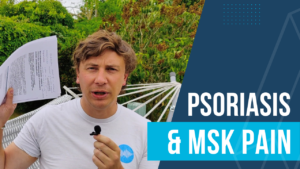Welcome back to the blog! A change of pace from recognition this month as we look at actually treating/managing/rehabbing! Exercise is a vital component of Rheumatoid Arthritis management and unfortunately people with RA fear it and don’t reach their targets for activity.
The recurrent features are back with legend of the blog and music with Kasabian at the bottom of the page.
Please consider heading to the shop to find more resources and supporting me to continue this hairbrained project! Or you can Buy A Coffee
You can also listen to all of my blogs as podcasts subscribe to your preferred channel HERE You can also find my podcast on Apple & Spotify & Google
As usual feedback is greatly appreciated and any further reading for me please send it my way!
PLEASE REMEMBER – THIS BLOG IS NOT A REPLACEMENT FOR CLINICAL REASONING, IF YOU ARE UNSURE GET ADVICE
This weeks legend of the blog is Rob Tyer who is an amazing sounding board, thinking challenger and friend. Check out his “Hip At A Glance” Booklet and follow him on twitter
Introduction
Lets talk about prescribing exercise for Rheumatoid Arthritis, first I want to cover some basic advice that should help frame the rest of the blog.
- Exercise is safe for people with RA
- Exercise should absolutely be encouraged in RA
- We need to cover the bases of Cardiovascular, Strengthening and flexibility
- One of the biggest barriers to exercise in RA is fear
So to elaborate a little on those bullet points. Research has shown that exercise including high intensity exercise is safe in Rheumatoid Arthritis it does not increase any measurable component of disease activity. Exercise is a vital component to maintain function, bone density, cardiovascular fitness and flexibility. People with Rheumatoid arthritis show reduced muscle bulk and strength compared to matched controls and addressing this should be considered for all. One of the biggest barriers to exercise is fear of increasing symptoms or worsening the arthritis, we must work hard to ensure we are reassuring people that this is not the case, individualising the programs appropriately and taking care of the narratives they are taking away from our sessions.
Components
All people with Rheumatoid Arthritis (and to a degree I would argue those suspected of having it as well) should be encouraged to undertake exercise programs that contain the following components:
- Cardiovascular exercise
- Strengthening exercises
- Flexibility
- Hand exercise program (example)
The amount of these components will vary per individual depending upon their circumstances, functional limitations, personal preferences and access.
As a starting point, ensuring people reach the minimum recommended activity levels will be challenge for some.
Intensity
There are no special rules regarding intensity in this cohort of people. Ensure you are considering the goals of the exercise program when setting this. I advocate for graded increases in the program as appropriate for the individual just as you would with any exercise prescription. They need to overcome adaptation and retain a level of challenge to the program.
Provide the individual with the skillset to adapt the intensity of the program themselves, when it starts to get too easy they need to increase the parameters. This might be increased load, duration, speed, sets, reps… For people with RA it is also important to teach them how to decrease these components in a “flare” situation appropriately. Allow them to continue with a modified version of the program while their symptoms settle down. Its not that exercising through a flare is problematic per say but it will likely feel pretty damn awful. Other options are to exercise around flared joints.
Variation
Similar to above, ensure the person has variation within their programs, accommodation is one issue but so is boredom! Plus the ability to pick and choose components to suit any flared joints or other issues which allow them to continue a program despite these hurdles.
Individualisation
Ask the person what they would like their program to consist of and generate options relating to that. Gym goers are relatively easy to sort a program for but consider those whose main activities are walking the dog or gardening. How can you adapt these to include the 4 components discussed at the start of the blog. Some ideas I have implemented in the past:
- Adding a weighted back pack during activities
- Graded increases in duration or speed of dog walking
- Incorporating heavier jobs into gardening
All these components can again include graded increases to continue to challenge the individual.
Function
If someone presents with a functional deficit, provide them with exercises to try and improve that function…
Considerations
While there is no increased danger to a Rheumatoid Arthritic joint from exercise we still need to consider the repercussions. We know that it is normal to get soreness especially after starting a new activity and people should be counselled on what to expect. With regards to inflammation, it is likely that a joint will show increases in one or more of swelling, redness, heat and pain. This needs to be an acceptable level of increase to the individual and should resolve (return to pre-exercise state) by the following morning. This is more from a tolerance and comfort perspective for the person than any other reason. It is not going to be very nice if your exercise program causes you to not be able to sleep or walk for 2 days afterwards. With all these things, what is acceptable/tolerable for one person will not be for another so work with them on this and be prepared/prepare them to get this wrong on occasion.
Conclusion
I hope you have found this useful, individualising programs to the person is the key and it is of utmost importance to remain reassuring with positive narratives.
Music Choice: Kasabian – “Fast Fuse”
“Oh baby I was born
With a fast fuse
I’ve got no time to lose”


